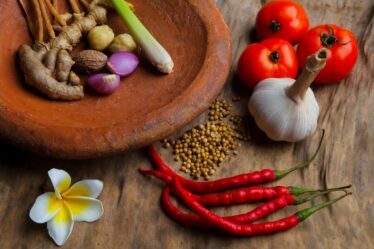
Spices have been an integral part of human civilization for thousands of years. They are derived from various parts of plants, such as seeds, bark, roots, and fruits, and are used to enhance the flavor and aroma of food. In addition to their culinary uses, spices also offer a wide range of health benefits and have been used in traditional medicine for centuries.
The history of spices dates back to ancient times when they were highly valued for their medicinal properties and were even used as currency. The spice trade played a significant role in shaping world history, with explorers and traders venturing to distant lands in search of valuable spices. The demand for spices led to the discovery of new trade routes and the colonization of various regions.
Using spices in cooking not only adds depth and complexity to dishes but also offers numerous health benefits. Many spices have antioxidant, anti-inflammatory, and antimicrobial properties that can boost the immune system and improve overall well-being. Spices are also known to aid digestion, reduce inflammation, and even help with weight loss. Incorporating spices into your daily diet can be a simple yet effective way to improve your health.
Key Takeaways
- Spices offer numerous benefits and uses in cooking, health, and beyond.
- The top 10 spices every home cook should have in their pantry include cinnamon, cumin, paprika, turmeric, and more.
- Proper storage and preservation of spices is crucial for maintaining maximum flavor and freshness.
- Cooking with spices requires experimentation and knowledge of how to balance flavors.
- Spices can boost your immune system and improve your well-being, making them a valuable addition to any diet.
The Top 10 Spices Every Home Cook Should Have in Their Pantry
1. Cumin: Cumin has a warm, earthy flavor with a hint of citrus. It is commonly used in Indian, Mexican, and Middle Eastern cuisines. Cumin is versatile and can be used in both savory and sweet dishes. It pairs well with meats, vegetables, soups, and stews.
2. Paprika: Paprika is made from dried red peppers and has a sweet and smoky flavor. It is commonly used in Hungarian and Spanish cuisines. Paprika adds color and flavor to dishes such as stews, soups, roasted meats, and grilled vegetables.
3. Cinnamon: Cinnamon has a sweet and warm flavor with a hint of spiciness. It is commonly used in baking and desserts but can also be used in savory dishes. Cinnamon pairs well with apples, pears, chocolate, and warm spices like nutmeg and cloves.
4. Turmeric: Turmeric has a bright yellow color and a warm, slightly bitter flavor. It is commonly used in Indian and Southeast Asian cuisines. Turmeric is known for its anti-inflammatory properties and is often used in curries, rice dishes, and smoothies.
5. Ginger: Ginger has a spicy and slightly sweet flavor with a hint of citrus. It is commonly used in Asian and Indian cuisines. Ginger adds warmth and depth to dishes such as stir-fries, soups, marinades, and baked goods.
6. Garlic: Garlic has a pungent and savory flavor. It is used in cuisines around the world and is a staple ingredient in many dishes. Garlic can be used in both raw and cooked forms and pairs well with meats, vegetables, pasta, and sauces.
7. Black Pepper: Black pepper has a sharp and spicy flavor. It is one of the most widely used spices in the world. Black pepper can be used in both savory and sweet dishes and pairs well with almost any ingredient.
8. Chili Powder: Chili powder is made from dried chili peppers and has a spicy and smoky flavor. It is commonly used in Mexican, Tex-Mex, and Southwestern cuisines. Chili powder adds heat and flavor to dishes such as chili, tacos, enchiladas, and salsas.
9. Nutmeg: Nutmeg has a warm and sweet flavor with a hint of spiciness. It is commonly used in baking, desserts, and savory dishes. Nutmeg pairs well with fruits, dairy products, chocolate, and warm spices like cinnamon and cloves.
10. Oregano: Oregano has a strong and aromatic flavor. It is commonly used in Mediterranean and Italian cuisines. Oregano is often used in tomato-based dishes, pasta sauces, pizzas, and grilled meats.
To incorporate these spices into everyday cooking, start by experimenting with different combinations and flavors. Use them to season meats, vegetables, soups, stews, sauces, and marinades. Don’t be afraid to get creative and try new recipes. Spices can transform a simple dish into a flavorful masterpiece.
How to Store and Preserve Spices to Ensure Maximum Flavor and Freshness
Proper storage is essential to maintain the flavor and freshness of spices. Exposure to air, light, heat, and moisture can cause spices to lose their potency and flavor over time. Here are some tips for storing and preserving spices:
1. Choose the right storage containers: Spices should be stored in airtight containers to prevent moisture and air from getting in. Glass jars with tight-fitting lids are ideal for storing spices as they do not absorb odors or flavors.
2. Keep spices away from light: Light can cause spices to lose their color and flavor. Store spices in a cool, dark place such as a pantry or cupboard away from direct sunlight.
3. Avoid heat and moisture: Heat and moisture can cause spices to clump together and lose their flavor. Keep spices away from the stove, oven, dishwasher, or any other source of heat or moisture.
4. Label and date your spices: It’s important to label your spices with their name and date of purchase or expiration. This will help you keep track of when you bought them and when they need to be replaced.
5. Store whole spices for longer shelf life: Whole spices have a longer shelf life compared to ground spices as they retain their flavor for a longer period of time. Consider buying whole spices and grinding them as needed for maximum freshness.
To determine if a spice has gone bad, use your senses. Look for any signs of mold, discoloration, or clumping. Smell the spice to check if it still has a strong aroma. Taste a small amount to see if it still has a potent flavor. If the spice has lost its color, aroma, or flavor, it is best to replace it.
Cooking with Spices: Tips and Tricks for Enhancing Your Dishes
| Spice | Flavor Profile | Common Dishes | Health Benefits |
|---|---|---|---|
| Cumin | Earthy, nutty, warm | Chili, tacos, curries | May aid digestion, anti-inflammatory |
| Cinnamon | Sweet, warm, spicy | Baked goods, oatmeal, coffee | May lower blood sugar, anti-inflammatory |
| Turmeric | Earthy, slightly bitter, pungent | Curries, rice dishes, smoothies | May reduce inflammation, antioxidant |
| Paprika | Sweet, smoky, slightly bitter | Meat rubs, stews, soups | May improve digestion, anti-inflammatory |
| Ginger | Spicy, warm, slightly sweet | Stir-fries, marinades, tea | May reduce nausea, anti-inflammatory |
When cooking with spices, it’s important to balance flavors and use them in the right quantities. Here are some tips and tricks for enhancing your dishes with spices:
1. Start with small amounts: It’s best to start with small amounts of spices and gradually add more if needed. This will allow you to adjust the flavor according to your taste preferences.
2. Toast spices for added depth: Toasting spices before using them can enhance their flavor and aroma. Simply heat a dry skillet over medium heat and add the spices. Toast them for a few minutes until fragrant, stirring constantly to prevent burning.
3. Use spices in different forms: Spices can be used in various forms such as whole, ground, or as a paste. Each form has its own unique flavor profile and intensity. Experiment with different forms to find the one that suits your dish best.
4. Pair spices with complementary ingredients: Certain spices pair well with specific ingredients and can enhance their flavors. For example, cinnamon pairs well with apples, nutmeg pairs well with pumpkin, and cumin pairs well with lamb.
5. Balance flavors with spices: When using spices, it’s important to balance flavors by combining sweet, salty, sour, and spicy elements. This will create a harmonious blend of flavors in your dish.
6. Use spices in marinades and rubs: Spices can add depth and flavor to marinades and rubs for meats, poultry, and seafood. Combine spices with oil, vinegar, citrus juice, and herbs to create a flavorful marinade or rub.
7. Experiment with spice blends: Spice blends are a combination of different spices that work well together. They can be used to season meats, vegetables, soups, stews, and sauces. Experiment with different spice blends to add complexity to your dishes.
The Health Benefits of Spices: How They Can Boost Your Immune System and Improve Your Well-Being
Spices not only add flavor to your dishes but also offer a wide range of health benefits. Here are some of the health benefits of spices:
1. Anti-inflammatory properties: Many spices have anti-inflammatory properties that can help reduce inflammation in the body. Chronic inflammation is linked to various health conditions such as heart disease, diabetes, and arthritis.
2. Antioxidant properties: Spices are rich in antioxidants that help protect the body against free radicals, which can cause oxidative stress and damage to cells. Antioxidants are important for overall health and can help prevent chronic diseases.
3. Digestive benefits: Spices such as ginger, turmeric, and cumin have been used for centuries to aid digestion. They can help relieve symptoms of indigestion, bloating, and nausea.
4. Immune-boosting properties: Many spices have immune-boosting properties that can help strengthen the immune system and protect against infections and diseases. Garlic, ginger, turmeric, and cinnamon are known for their immune-boosting properties.
5. Weight management: Some spices, such as cayenne pepper and black pepper, have been shown to increase metabolism and promote weight loss. They can also help suppress appetite and reduce cravings.
To incorporate spices into a healthy diet, start by adding them to your everyday cooking. Use them to season meats, vegetables, soups, stews, sauces, and marinades. You can also add spices to smoothies, teas, and homemade dressings. Be creative and experiment with different spice combinations to create flavorful and healthy dishes.
Spices from Around the World: Exploring the Flavors of Different Cultures

Spices are an integral part of various cuisines around the world. Each region has its own unique spice blends and flavor profiles. Here are some spices from different regions and their common uses:
1. Indian Spices: Indian cuisine is known for its bold and aromatic flavors. Common spices used in Indian cooking include cumin, coriander, turmeric, cardamom, cinnamon, cloves, and fenugreek. These spices are used in curries, rice dishes, lentil soups, and chutneys.
2. Mediterranean Spices: Mediterranean cuisine is characterized by fresh and vibrant flavors. Common spices used in Mediterranean cooking include oregano, thyme, rosemary, basil, parsley, and garlic. These spices are used in salads, grilled meats, roasted vegetables, and pasta dishes.
3. Mexican Spices: Mexican cuisine is known for its spicy and flavorful dishes. Common spices used in Mexican cooking include chili powder, cumin, oregano, paprika, cinnamon, and cloves. These spices are used in salsas, tacos, enchiladas, and mole sauces.
4. Middle Eastern Spices: Middle Eastern cuisine is known for its aromatic and exotic flavors. Common spices used in Middle Eastern cooking include cumin, coriander, turmeric, cinnamon, cardamom, sumac, and za’atar. These spices are used in dishes such as hummus, falafel, kebabs, and pilaf.
5. Asian Spices: Asian cuisine is diverse and encompasses a wide range of flavors. Common spices used in Asian cooking include ginger, garlic, lemongrass, chili, soy sauce, and fish sauce. These spices are used in stir-fries, curries, soups, and noodle dishes.
To explore the flavors of different cultures, try incorporating these spices into your cooking. Experiment with different spice blends and recipes to create authentic and flavorful dishes from around the world.
Spice Blends and Mixes: Creating Your Own Signature Seasonings
Creating your own spice blends and mixes allows you to customize the flavors according to your taste preferences. Here are some benefits of making your own spice blends:
1. Control over ingredients: When you make your own spice blends, you have control over the quality and freshness of the ingredients. You can choose organic or locally sourced spices and avoid additives or preservatives.
2. Customized flavors: Making your own spice blends allows you to customize the flavors according to your taste preferences. You can adjust the quantities of each spice to create a blend that suits your palate.
3. Cost-effective: Making your own spice blends can be more cost-effective in the long run compared to buying pre-packaged blends. You can buy spices in bulk and create larger quantities of blends at a lower cost.
Here are some tips for creating balanced spice blends:
1. Start with a base spice: Choose a base spice that will be the dominant flavor in your blend. This could be something like cumin, paprika, or chili powder.
2. Add complementary spices: Add spices that complement the base spice and enhance its flavor. For example, if you’re using cumin as the base spice, you could add coriander, turmeric, or cinnamon.
3. Experiment with ratios: Start with equal parts of each spice and adjust the ratios according to your taste preferences. Keep tasting as you go and make adjustments as needed.
4. Store in airtight containers: Once you’ve created your spice blend, store it in an airtight container to maintain its freshness and flavor. Label the container with the name of the blend and the date it was made.
Here are some popular spice blends and their common uses:
1. Garam Masala: Garam masala is a blend of spices commonly used in Indian cuisine. It typically includes cinnamon, cardamom, cloves, cumin, coriander, and black pepper. Garam masala is used in curries, rice dishes, and lentil soups.
2. Herbes de Provence: Herbes de Provence is a blend of herbs commonly used in Mediterranean cuisine. It typically includes thyme, rosemary, oregano, marjoram, and lavender. Herbes de Provence is used in roasted meats, grilled vegetables, and tomato-based dishes.
3. Chinese Five Spice: Chinese five spice is a blend of spices commonly used in Chinese cuisine. It typically includes star anise, cloves, cinnamon, Sichuan peppercorns, and fennel seeds. Chinese five spice is used in stir-fries, marinades, and roasted meats.
4. Cajun Seasoning: Cajun seasoning is a blend of spices commonly used in Cajun and Creole cuisines. It typically includes paprika, cayenne pepper, garlic powder, onion powder, thyme, oregano, and black pepper. Cajun seasoning is used in seafood dishes, jambalaya, gumbo, and blackened meats.
Cooking with Fresh Herbs: How to Incorporate Them into Your Dishes
Fresh herbs are a fantastic way to add flavor and depth to your cooking. Not only do they provide a burst of freshness, but they also offer a range of health benefits. Incorporating fresh herbs into your dishes is easy and can elevate the taste of any meal. One simple way to use fresh herbs is by adding them to salads or as a garnish for soups and stews. You can also infuse oils or vinegars with herbs to create flavorful dressings or marinades. Another popular method is to chop or mince fresh herbs and mix them into sauces, dips, or spreads. Additionally, you can use herbs as a rub or seasoning for meats, fish, or vegetables before grilling or roasting. The possibilities are endless when it comes to cooking with fresh herbs, so don’t be afraid to experiment and discover new flavor combinations that will enhance your culinary creations.
If you’re a food enthusiast looking to explore new flavors, you won’t want to miss out on the joys of casaba melon. This unique fruit is not only delicious but also versatile in its culinary applications. From refreshing salads to delightful desserts, casaba melon can add a burst of sweetness and aroma to your dishes. To learn more about this exotic ingredient and how to incorporate it into your cooking, check out this informative article on Flavorful Sips: Discover the Joys of Casaba Melon: A Foodie’s Guide. And while you’re at it, don’t forget to explore their other mouthwatering recipes like the easy zucchini bread recipe guide (link here) and the easy tuna noodle casserole recipe (link here). Happy cooking!



